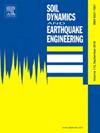Behaviors of suction bucket foundations in sands under vertical tensile load and seismic action
IF 4.2
2区 工程技术
Q1 ENGINEERING, GEOLOGICAL
引用次数: 0
Abstract
Seismic activity often triggers liquefaction in sandy soils, which coupled with initial vertical tensile loads, poses a significant threat to the stability of suction bucket foundations for floating wind turbines. However, there remains a notable dearth of studies on the dynamic response of these foundations under combined seismic and vertical tensile loads. Therefore, this study developed a numerical method for analyzing the dynamic response of suction bucket foundations in sandy soils under such combined loading conditions. Through numerical simulations across various scenarios, this research investigates the influence of key factors such as seismic intensity, spectral characteristics, as well as the magnitude and direction of tensile loads on the seismic response of suction buckets. The results revealed that the strong earthquake may cause the suction bucket foundation of floating wind turbines to fail due to excessive vertical upward displacement. This can be attributed to that the accumulation of excess pore water pressure reduces the normal effective stress on the outer wall of bucket, and consequently decreases the frictional resistance of bucket-soil interface. Additionally, the above factors significantly influence both the vertical displacement of the suction bucket and the development of pore pressure in the surrounding soil. The findings can provide valuable insights for the seismic safety assessment of suction bucket foundations used in tension-leg floating wind turbines.
竖向拉伸荷载和地震作用下砂土中吸力桶型基础的性能
地震活动经常引发砂土液化,加之初始垂直拉伸载荷,对浮式风力发电机组吸力桶基础的稳定性构成重大威胁。然而,对于这些基础在地震和竖向拉载荷联合作用下的动力响应研究仍然非常缺乏。因此,本研究提出了一种分析沙土中吸力桶型基础在这种组合荷载条件下动力响应的数值方法。通过不同场景下的数值模拟,研究了地震烈度、频谱特征、拉伸荷载的大小和方向等关键因素对吸力桶地震响应的影响。结果表明,强震作用下,浮式风力发电机组吸力桶基础可能因竖向向上位移过大而失效。这是由于超孔隙水压力的积累降低了桶外壁的法向有效应力,从而降低了桶-土界面的摩擦阻力。此外,上述因素对吸力斗的竖向位移和周围土体孔隙压力的发展都有显著影响。研究结果可为张力腿式浮式风力机吸力桶基础的抗震安全性评估提供有价值的见解。
本文章由计算机程序翻译,如有差异,请以英文原文为准。
求助全文
约1分钟内获得全文
求助全文
来源期刊

Soil Dynamics and Earthquake Engineering
工程技术-地球科学综合
CiteScore
7.50
自引率
15.00%
发文量
446
审稿时长
8 months
期刊介绍:
The journal aims to encourage and enhance the role of mechanics and other disciplines as they relate to earthquake engineering by providing opportunities for the publication of the work of applied mathematicians, engineers and other applied scientists involved in solving problems closely related to the field of earthquake engineering and geotechnical earthquake engineering.
Emphasis is placed on new concepts and techniques, but case histories will also be published if they enhance the presentation and understanding of new technical concepts.
 求助内容:
求助内容: 应助结果提醒方式:
应助结果提醒方式:


